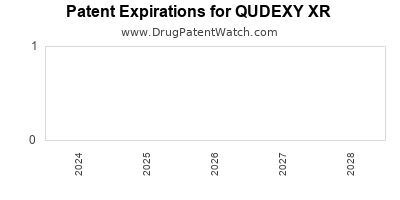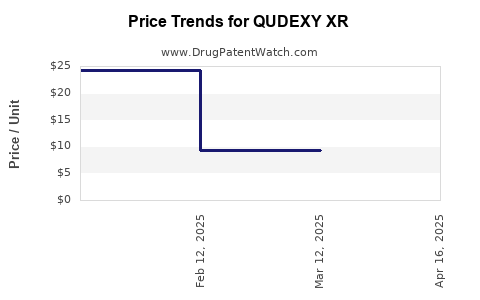QUDEXY XR Drug Patent Profile
✉ Email this page to a colleague
When do Qudexy Xr patents expire, and what generic alternatives are available?
Qudexy Xr is a drug marketed by Upsher Smith Labs and is included in one NDA. There are five patents protecting this drug and one Paragraph IV challenge.
This drug has ten patent family members in six countries.
The generic ingredient in QUDEXY XR is topiramate. There are twenty-six drug master file entries for this compound. Forty-seven suppliers are listed for this compound. Additional details are available on the topiramate profile page.
DrugPatentWatch® Litigation and Generic Entry Outlook for Qudexy Xr
A generic version of QUDEXY XR was approved as topiramate by ACCORD HLTHCARE on March 27th, 2009.
AI Deep Research
Questions you can ask:
- What is the 5 year forecast for QUDEXY XR?
- What are the global sales for QUDEXY XR?
- What is Average Wholesale Price for QUDEXY XR?
Summary for QUDEXY XR
| International Patents: | 10 |
| US Patents: | 5 |
| Applicants: | 1 |
| NDAs: | 1 |
| Finished Product Suppliers / Packagers: | 1 |
| Raw Ingredient (Bulk) Api Vendors: | 1 |
| Clinical Trials: | 1 |
| Patent Applications: | 2,695 |
| Drug Prices: | Drug price information for QUDEXY XR |
| Drug Sales Revenues: | Drug sales revenues for QUDEXY XR |
| Patent Litigation and PTAB cases: | See patent lawsuits and PTAB cases for QUDEXY XR |
| DailyMed Link: | QUDEXY XR at DailyMed |



Recent Clinical Trials for QUDEXY XR
Identify potential brand extensions & 505(b)(2) entrants
| Sponsor | Phase |
|---|---|
| Upsher-Smith Laboratories | Phase 4 |
Pharmacology for QUDEXY XR
| Mechanism of Action | Cytochrome P450 2C19 Inhibitors Cytochrome P450 3A4 Inducers |
| Physiological Effect | Decreased Central Nervous System Disorganized Electrical Activity |
Paragraph IV (Patent) Challenges for QUDEXY XR
| Tradename | Dosage | Ingredient | Strength | NDA | ANDAs Submitted | Submissiondate |
|---|---|---|---|---|---|---|
| QUDEXY XR | Extended-release Capsules | topiramate | 25 mg, 50 mg, 100 mg, 150 mg, and 200 mg | 205122 | 1 | 2015-12-24 |
US Patents and Regulatory Information for QUDEXY XR
QUDEXY XR is protected by five US patents.
| Applicant | Tradename | Generic Name | Dosage | NDA | Approval Date | TE | Type | RLD | RS | Patent No. | Patent Expiration | Product | Substance | Delist Req. | Exclusivity Expiration |
|---|---|---|---|---|---|---|---|---|---|---|---|---|---|---|---|
| Upsher Smith Labs | QUDEXY XR | topiramate | CAPSULE, EXTENDED RELEASE;ORAL | 205122-001 | Mar 11, 2014 | AB2 | RX | Yes | No | 10,363,224 | ⤷ Get Started Free | ⤷ Get Started Free | |||
| Upsher Smith Labs | QUDEXY XR | topiramate | CAPSULE, EXTENDED RELEASE;ORAL | 205122-004 | Mar 11, 2014 | AB2 | RX | Yes | No | 8,652,527 | ⤷ Get Started Free | Y | ⤷ Get Started Free | ||
| Upsher Smith Labs | QUDEXY XR | topiramate | CAPSULE, EXTENDED RELEASE;ORAL | 205122-005 | Mar 11, 2014 | AB2 | RX | Yes | Yes | 9,101,545 | ⤷ Get Started Free | Y | ⤷ Get Started Free | ||
| Upsher Smith Labs | QUDEXY XR | topiramate | CAPSULE, EXTENDED RELEASE;ORAL | 205122-002 | Mar 11, 2014 | AB2 | RX | Yes | No | 9,555,005 | ⤷ Get Started Free | Y | ⤷ Get Started Free | ||
| >Applicant | >Tradename | >Generic Name | >Dosage | >NDA | >Approval Date | >TE | >Type | >RLD | >RS | >Patent No. | >Patent Expiration | >Product | >Substance | >Delist Req. | >Exclusivity Expiration |
International Patents for QUDEXY XR
See the table below for patents covering QUDEXY XR around the world.
| Country | Patent Number | Title | Estimated Expiration |
|---|---|---|---|
| Israel | 241053 | קפסולות של טופיראמאט עם שחרור מושהה (Extended-release topiramate capsules) | ⤷ Get Started Free |
| Canada | 2905011 | CAPSULE DE TOPIRAMATE A LIBERATION LENTE (EXTENDED-RELEASE TOPIRAMATE CAPSULES) | ⤷ Get Started Free |
| Canada | 2905011 | CAPSULE DE TOPIRAMATE A LIBERATION LENTE (EXTENDED-RELEASE TOPIRAMATE CAPSULES) | ⤷ Get Started Free |
| South Korea | 20200010608 | 서방성 토피라메이트 캡슐 (EXTENDED-RELEASE TOPIRAMATE CAPSULES) | ⤷ Get Started Free |
| >Country | >Patent Number | >Title | >Estimated Expiration |
Supplementary Protection Certificates for QUDEXY XR
| Patent Number | Supplementary Protection Certificate | SPC Country | SPC Expiration | SPC Description |
|---|---|---|---|---|
| 2317997 | 2190050-1 | Sweden | ⤷ Get Started Free | PRODUCT NAME: PHENTERMINE AND TOPIRAMATE; NAT. REG. NO/DATE: 59574-59577 20210617; FIRST REG.: IS IS/1/21/018/01-04 20210212 |
| 0138441 | SPC/GB95/028 | United Kingdom | ⤷ Get Started Free | PRODUCT NAME: TOPIRAMATE; REGISTERED: UK 0242/0301 19950718 |
| >Patent Number | >Supplementary Protection Certificate | >SPC Country | >SPC Expiration | >SPC Description |
Market Dynamics and Financial Trajectory for QUDEXY XR
More… ↓
Make Better Decisions: Try a trial or see plans & pricing
Drugs may be covered by multiple patents or regulatory protections. All trademarks and applicant names are the property of their respective owners or licensors. Although great care is taken in the proper and correct provision of this service, thinkBiotech LLC does not accept any responsibility for possible consequences of errors or omissions in the provided data. The data presented herein is for information purposes only. There is no warranty that the data contained herein is error free. We do not provide individual investment advice. This service is not registered with any financial regulatory agency. The information we publish is educational only and based on our opinions plus our models. By using DrugPatentWatch you acknowledge that we do not provide personalized recommendations or advice. thinkBiotech performs no independent verification of facts as provided by public sources nor are attempts made to provide legal or investing advice. Any reliance on data provided herein is done solely at the discretion of the user. Users of this service are advised to seek professional advice and independent confirmation before considering acting on any of the provided information. thinkBiotech LLC reserves the right to amend, extend or withdraw any part or all of the offered service without notice.
